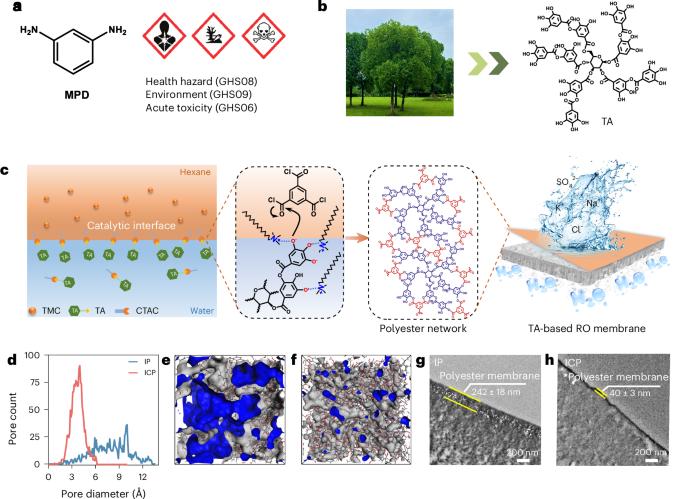Sustainable polyester thin films for membrane desalination developed through interfacial catalytic polymerization
IF 24.1
引用次数: 0
Abstract
Reverse osmosis membranes are essential in wastewater treatment, water reuse and desalination, but conventional polyamide reverse osmosis membranes rely on toxic amine monomers such as m-phenylenediamine, posing notable health risks. Here we show that an interfacial catalytic polymerization strategy enables the development of sustainable polyester thin films for membrane desalination. This approach improves reaction kinetics and polymerization control, facilitating the efficient polymerization of nature-derived phenol and alcohol compounds as non-toxic, cost-effective and environmentally friendly alternatives to m-phenylenediamine. The interfacial catalyst enhances both monomer diffusion and polymerization, overcoming the limited reactivity of nature-derived monomers to produce homogeneous, dense polyester thin films. The resulting membranes exhibit excellent desalination performance (NaCl rejection 99.2%; flux 31.7 l m−2 h−1 at 15 bar), comparable to commercial BW30 membranes at both coupon and spiral-wound module scales, demonstrating their potential for practical membrane desalination. This work paves the way for further development of sustainable, nature-derived membrane materials for desalination technologies. An interfacial catalytic polymerization strategy is able to turn nature-derived compounds into high-quality membranes for reverse osmosis, challenging traditional approaches for membrane production that use toxic amine-based monomers.

采用界面催化聚合技术研制了用于膜脱盐的可持续聚酯薄膜
反渗透膜在废水处理、水回用和海水淡化中是必不可少的,但传统的聚酰胺反渗透膜依赖于有毒的胺单体,如间苯二胺,构成明显的健康风险。在这里,我们展示了一种界面催化聚合策略,使可持续发展的聚酯薄膜用于膜脱盐。这种方法改善了反应动力学和聚合控制,促进了天然衍生的酚和醇化合物的高效聚合,作为间苯二胺的无毒、经济、环保的替代品。界面催化剂促进了单体的扩散和聚合,克服了天然衍生单体的有限反应性,从而生产出均匀、致密的聚酯薄膜。所得膜具有优异的脱盐性能(NaCl去除率99.2%,通量31.7 l m−2 h−1,15 bar),与商业BW30膜在片状和螺旋缠绕模块规模相当,表明其在实际膜脱盐方面的潜力。这项工作为进一步开发用于海水淡化技术的可持续的、自然衍生的膜材料铺平了道路。界面催化聚合策略能够将天然化合物转化为用于反渗透的高质量膜,挑战使用有毒胺基单体的传统膜生产方法。
本文章由计算机程序翻译,如有差异,请以英文原文为准。
求助全文
约1分钟内获得全文
求助全文

 求助内容:
求助内容: 应助结果提醒方式:
应助结果提醒方式:


